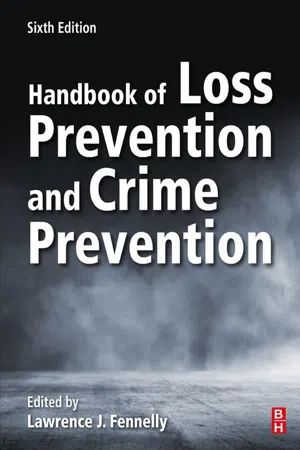
- 544 pages
- English
- ePUB (mobile friendly)
- Available on iOS & Android
Handbook of Loss Prevention and Crime Prevention
About this book
Handbook of Loss Prevention and Crime Prevention, Sixth Edition, continues to serve as the preeminent, comprehensive resource for devising practical, modern solutions for securing people and property. The book presents the latest key applications for securing structures with Crime Prevention Through Environmental Design (CPTED), including plan review, report writing, presentation skills, lighting, zoning and behavioral management. Other sections address the latest issues related to active shooter situations, information technology, and international terrorism. Practical examples are provided, exploring applications for limiting retail crime and employing disaster readiness strategies.Edited by seasoned, trusted security practitioner Lawrence Fennelly, the book features contributions by some of the most well-known experts in the field. Readers will find this book to be a trusted resource for physical security professionals, students and certification candidates who must navigate, and make sense of, today's most pressing domestic and international security issues.- Covers every important topic in the field, including new coverage of active shooters, terroristic threats, and the latest on wireless security applications, data analysis and visualization, situational crime prevention, and global security standards and compliance issues- Provides a comprehensive examination on the content and skills necessary for passing the ASIS Certified Protection Professional (CPP) exam- Features contributions from the leading, most trusted subject-matter experts in the field
Frequently asked questions
- Essential is ideal for learners and professionals who enjoy exploring a wide range of subjects. Access the Essential Library with 800,000+ trusted titles and best-sellers across business, personal growth, and the humanities. Includes unlimited reading time and Standard Read Aloud voice.
- Complete: Perfect for advanced learners and researchers needing full, unrestricted access. Unlock 1.4M+ books across hundreds of subjects, including academic and specialized titles. The Complete Plan also includes advanced features like Premium Read Aloud and Research Assistant.
Please note we cannot support devices running on iOS 13 and Android 7 or earlier. Learn more about using the app.
Information
Designing security and working with architects, part 1
Abstract
Keywords
Introduction
Why get involved and work with architect?
Physical security systems
Natural surveillance and natural access control
How can design reduce crime?
Open spaces and landscaping
Table of contents
- Cover image
- Title page
- Table of Contents
- Copyright
- Dedication
- List of contributors
- Introduction
- Chapter 1. Designing security and working with architects, part 1
- Chapter 2. Designing security and working with architects part 2
- Chapter 3. Designing buildings and site layout
- Chapter 4. The 10 principles of crime prevention
- Chapter 5. International crime prevention
- Chapter 6. Crime prevention glossary of terms
- Chapter 7. Encompassing effective CPTED solutions in 2020 and beyond: concepts and strategies
- Chapter 8. Mental health issues and Crime Prevention Through Environmental Design
- Chapter 9. Encompassing effective crime prevention solutions in 2020 and beyond: concepts and strategies
- Chapter 10. What is crime prevention in 2020?
- Chapter 11. What is risk?
- Chapter 12. Vulnerability assessment process inputs—establish protection objectives
- Chapter 13. Security surveys and auditing
- Chapter 14. Unmanned aerial vehicle (drone) usage in the 21st century
- Chapter 15. The legalization of marijuana and the security industry
- Chapter 16. Active shooter: common-sense thinking, common-sense planning or in other words … thinking outside the box
- Chapter 17. Neighborhood Watch guidelines for the 21st century
- Chapter 18. Crime analysis
- Chapter 19. Environmental crime control
- Chapter 20. Alarms intrusion detection systems
- Chapter 21. Access control and biometrics
- Chapter 22. Security lighting
- Chapter 23. Chain-link fence standards
- Chapter 24. Bomb threats and the case against immediate evacuation
- Chapter 25. The use of locks in physical crime prevention
- Chapter 26. Security officers in the 21st century
- Chapter 27. Information technology systems infrastructure
- Chapter 28. Internal theft controls
- Chapter 29. Multiresidential security
- Chapter 30. Twenty-one ideas for a safer and more secure school
- Chapter 31. Crime and crime prevention
- Chapter 32. Domestic violence, take a stand against violence
- Chapter 33. Workplace violence: 2020 and beyond
- Chapter 34. Glass and windows
- Chapter 35. Fire alarm systems
- Chapter 36. Safes, vaults, and accessories
- Chapter 37. Corporate policy and procedures
- Chapter 38. The importance of CPR/AED and first aid training for security officers and SROs
- Chapter 39. Identity theft
- Chapter 40. Doors and door locks
- Chapter 41. Protective barriers and deterrents
- Chapter 42. Planning, management, and evaluation
- Chapter 43. Proprietary information
- Chapter 44. Ten risk factors
- Index